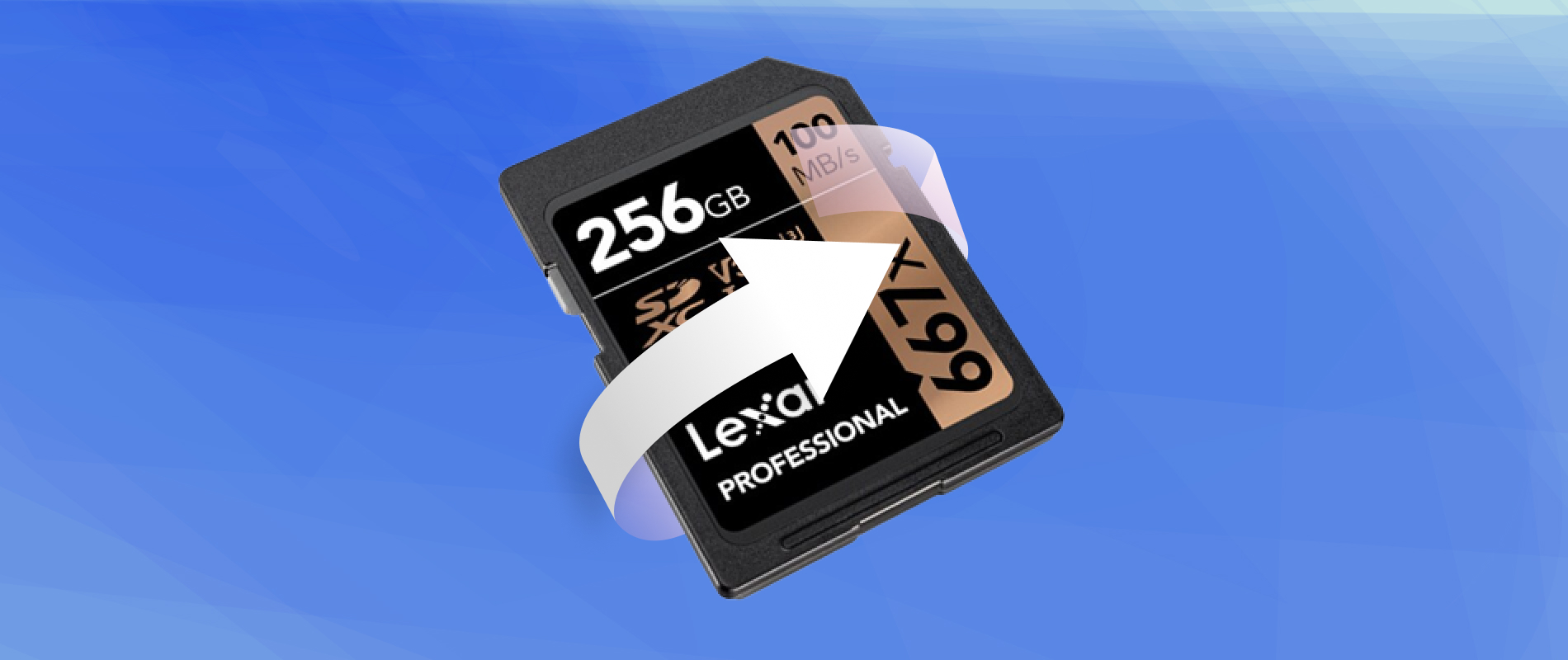Ahh, memory cards! Such a handy thing, used in so many modern devices, but they can cause so much pain when you find that your files have been deleted or disappeared.
But don’t despair! In this article, we’ll cover how to recover data from your memory card in a few simple steps.
SD Card Recovery Dos and Don’ts
Before we dive into the main part of this article, it’s crucial to discuss a few important details. Surprisingly, your actions can affect the chances of successfully recovering data from your memory card in both directions. Here are a few things we recommend you do before moving on to recovery:
- ⛔ Stop using your memory card: Your data is likely not deleted, but instead marked by the system as ready to be overwritten. Any further use of the memory card, whether it involves copying data to storage media on your PC or taking pictures on your camera, can lead to overwriting and permanent loss of your data.
- 🔍 Check your backups and recycle bin: You’re probably reading this article because you’re having issues with your memory card, but it’s always a good idea to remind you of this option. If you have created a backup of your data in advance, check it. Additionally, check for alternative repositories for deleted files, such as the Recycle Bin on your PC (although files from external media are often deleted bypassing the Recycle Bin). Some brands of digital cameras and camcorders also have built-in folders for recently deleted files. It won’t take long to check everything again.
- 🔁 Do not format your memory card: If your card has been logically corrupted, and its file system has been corrupted, your PC or recorder may require you to format the card before you can continue using it. We advise you to avoid this action before trying the methods described in this article.
- 🔬 Check your SD card for physical damage: If your memory card shows obvious signs of physical damage, such as breaks, temperature, or water exposure, consider contacting a specialized service immediately instead of attempting to solve the problem yourself. DIY methods can lead to more damage and eventually permanent data loss.
Can You Recover Deleted Files From an SD Card?
Yes, you can recover data from a memory card, including permanently deleted files.
Whether you use standard memory cards, microSD cards, miniSD cards, or more niche memory cards such as CF (CompactFlash), CFexpress, xD, XQD, SDHC, or SDXC, they all follow a simple formula: The success of data recovery depends on the reason for the deletion, as well as on the tool you choose for the recovery procedure.
Spoiler alert: Yes, in this article, we will use data recovery software as our primary SD card recovery solution. We will get to that soon. But for now, let’s focus on the causes of data loss from your memory card and the chances of data recovery for each of them:
- File Deletion: This is the most common reason and, at the same time, the most fortunate scenario since the chances of recovery, in this case, are the most probable. Regardless of whether you accidentally deleted data from your memory card or did it intentionally, thinking that you no longer needed it and only then realizing that you made a mistake, your files, photos, and videos can be easily recovered with the proper tool. This applies to deleting files from your memory card while it was connected to your PC and deleting from inside the device in which you are using the memory card.
- SD Card Formatting: This is a more complicated scenario in which recovery measures still have a fairly high chance of success. The trick is that it all depends on exactly how the memory card was formatted. If it was standard formatting (also known as quick formatting), then you have nothing to worry about. Your device just placed a new file system on top of the old one without deleting the data on it (again, unless you managed to overwrite it using the card). The same goes for formatting within recorders. Most of them format memory cards with a quick format. As for full formatting, the chances of recovering your data in such a case tend to be zero.
- SD Card Corruption: This is the most difficult of the scenarios we are considering today. Corruption may be of two types (based on the causes that led to it): logical corruption and physical corruption. While we have already talked about the physical nature of corruption in the previous section, logical corruption may be caused by a number of reasons, which could take a whole separate article to describe. The main thing you need to learn is that your card must be recognized by your machine and appear in the list of devices so that you can recover data from it. It is also important not to confuse the detection of the card as a device (in Windows Device Manager) with the appearance of the card in Windows File Explorer. Modern data recovery software can read data from a memory card that does not appear in Windows File Explorer.
So, we hope you are already armed with the necessary knowledge about the nature of memory card data loss and the chances of recovering it. Let’s quickly move on to recovering data from the memory card.
How to Recover Deleted Files From an SD Card
As you may have already understood from the previous sections, one of the most important aspects (if not the most important) of memory card data recovery is choosing the right memory card data recovery software that suits your needs.
This is crucial because, despite the large variety and visual similarities between the tools, there are a lot of differences “under the hood”. A truly high-quality software can not only recover deleted files but also recover data from formatted memory cards, corrupted memory cards that ask to be formatted, cards whose file system has become RAW, and even memory cards that may not be fully recognized by your PC or laptop.
Important: In rare cases, the data recovery process may differ depending on the type of memory card and its specifications, but it almost never depends on the memory card manufacturer. This means that data recovery from Sony, SanDisk, Gigastone, Lexar, Panasonic, or even SmartBuy memory cards has the same flow.
So, today we’ve chosen two tools for you that our editorial team thinks are worthy of your attention:
Option A: Disk Drill
Our editorial team loves Disk Drill for its versatility. It works equally well on Windows and Mac, has a clean and visually pleasing interface, and, most importantly, has one of the highest data recovery rates. Despite its visual simplicity, it is a powerful software packed with many professional features. But all of this is general information. Below we have gathered a list of things that may be important to users whose goal is to recover data from the memory card:
- Disk Drill supports all major Windows and macOS file systems, including FAT32/NTFS which are most often used by memory cards.
- The tool supports a large number of file types, including RAW photos and videos, which may be of interest to professional and amateur filmmakers and photographers.
- Disk Drill can recover large files. This is especially important if you had a large number of high-resolution photos and videos stored on your memory card.
- The program allows you to preview a file before recovering it. This is important not only to make sure that you are planning to recover the correct file. It is also essential because a file that can be previewed is guaranteed to be recoverable. In addition, Disk Drill also shows you the chances of recovering each particular file.
- Disk Drill for Windows allows you to recover up to 500 MB of data for free. This should be enough for basic recovery, but may not be enough to recover the entire memory card (especially if it is large). But! Given the freeware nature of the product and the fact that the program allows you to verify the recoverability of data before upgrading to the PRO version, you are not paying for a pig in a poke.
To demonstrate the recovery process we will use a small memory card with several deleted JPG images, RAW photos (CR2, NEF), and videos (MP4):
- Go to the official CleverFiles website and download Disk Drill. At the time of writing this article, the most up-to-date version of the program is v5. In this version, the developers added a lot of interesting innovations, more details about which you can read here.
- Install Disk Drill. The installation file is lightweight and the installation itself takes a short duration. It is very important not to install the software on a device that has been affected by data loss. In our case, we installed Disk Drill on the system drive on our PC.
- Connect your memory card. In this step, the most important thing is to make sure that your memory card is displayed in Windows Device Manager.
- Start the program. Disk Drill will prompt for administrative permissions during startup. In the pop-up window, click Yes.
- Run the scan. To do this, you need to select your memory card (or one of its partitions, if necessary) in the list of available devices and click the Search for lost data button.
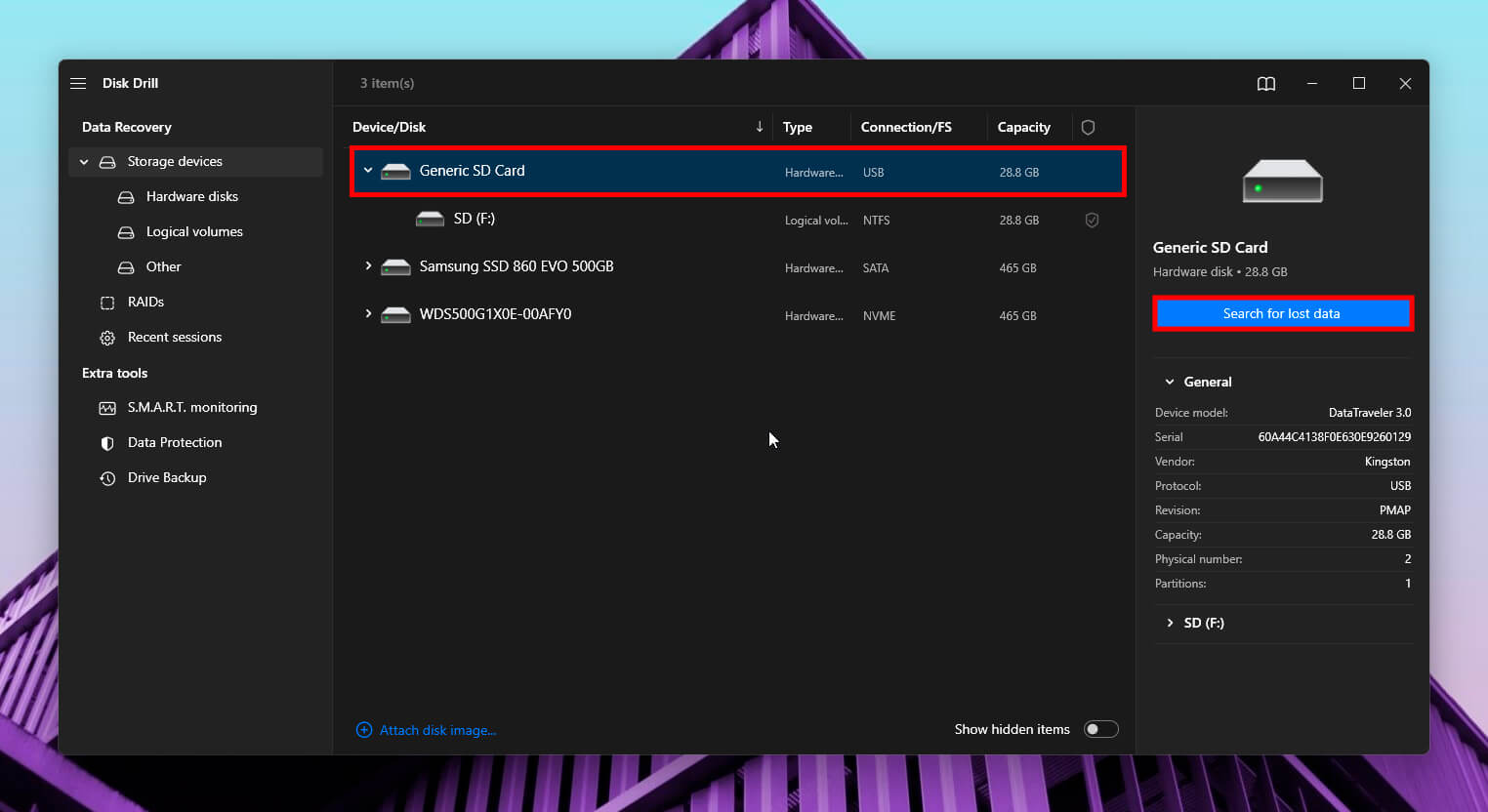
- Wait until the scan is complete. Disk Drill allows you to see the results in real-time during the scan, however, we recommend waiting until the end of the scan. As for the scanning speed, it depends on the capabilities of the software itself, as well as the size of your memory card and the reading speed of your device. Once the scan is complete, click on the Review found items button.
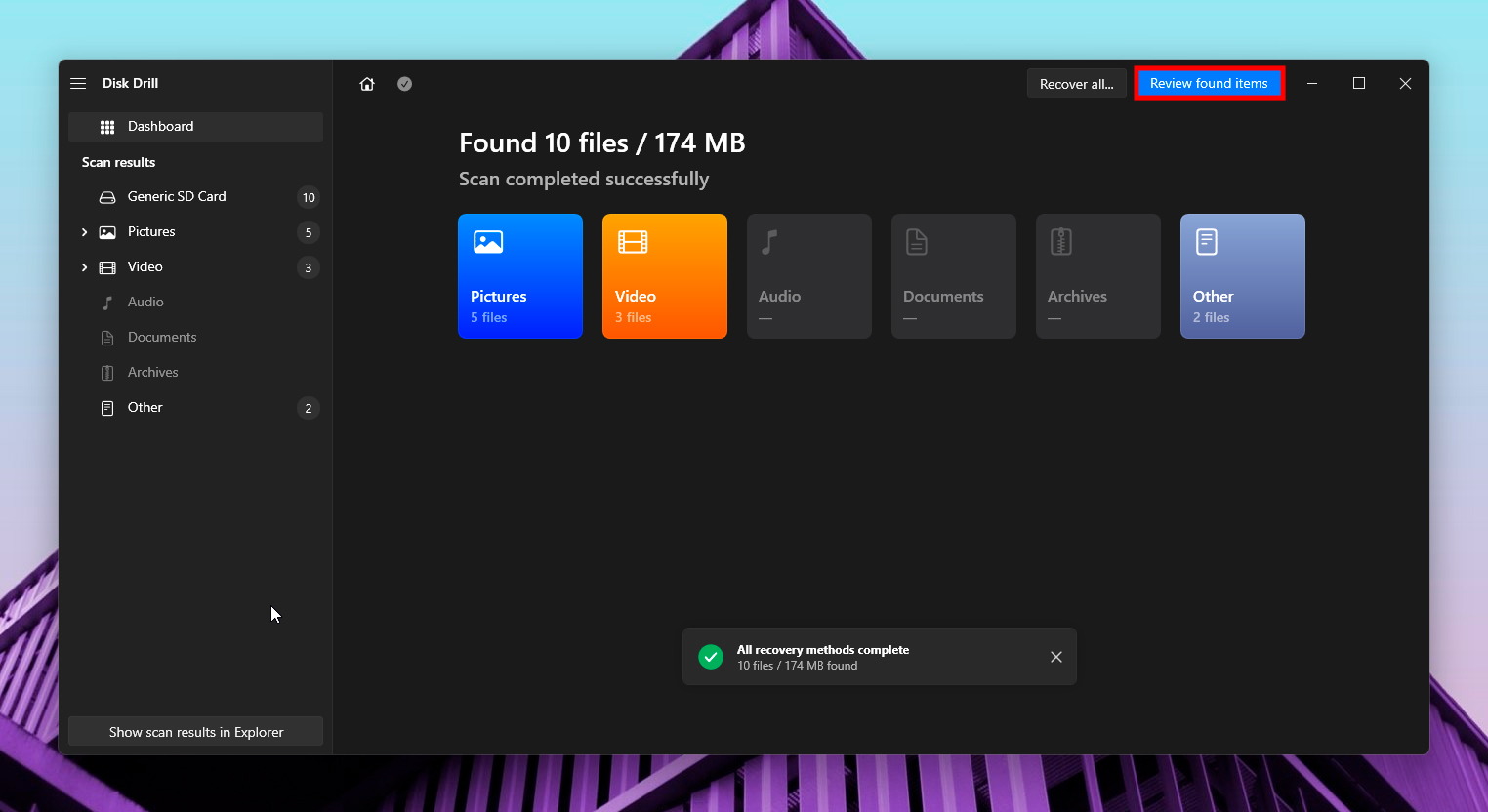
- Evaluate the scan results. You should start with the sidebar on the left, where you will see pre-categorized files found, such as pictures, videos, documents, and more. In each category, the files are further divided into subcategories by file type, which is very convenient. If you remember the name of the file you are looking for, or if you need a type of file that was not included in the automated grouping, you can use the search. To do this, just enter the file name or file type in the search bar. Examples will be in the screenshots below.
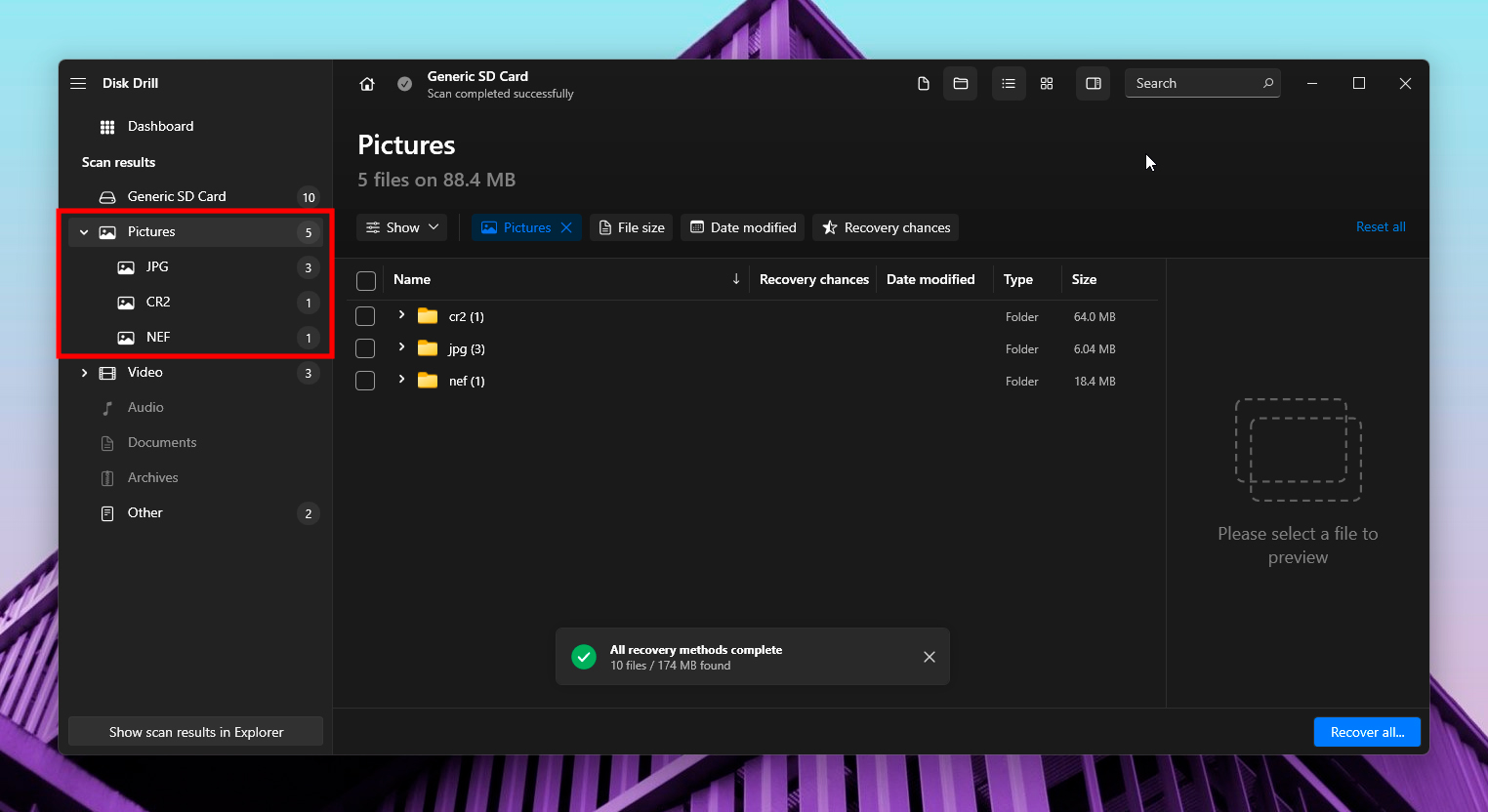
- Preview files. You can preview files by selecting the file you are interested in and clicking on the eye icon to the right of the file name. A preview window will appear on the right. Also, pay attention to the column with the chances of recovery.
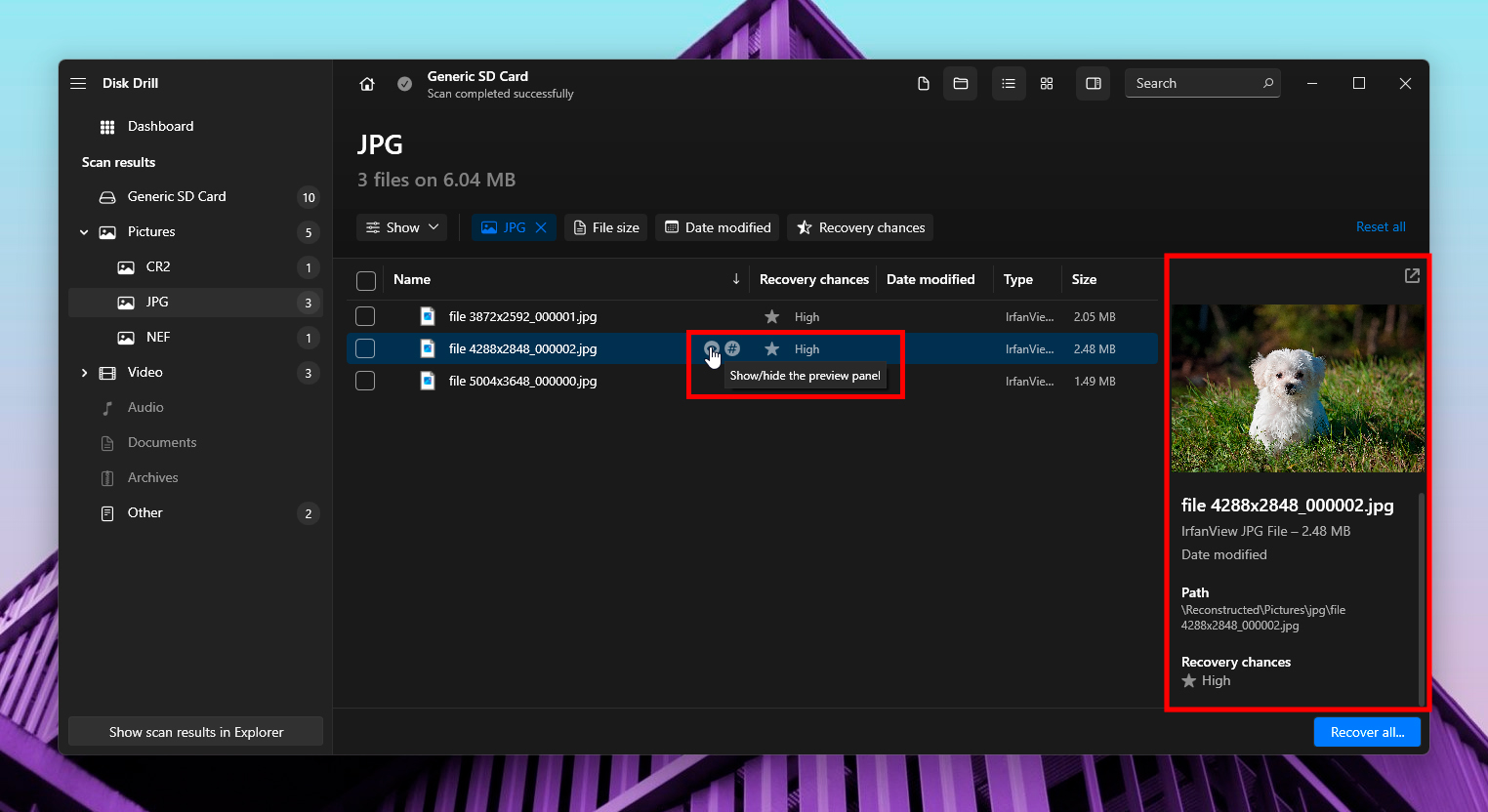
- Select the files you want to recover. You need to mark the files you want to restore using the checkbox to the left of the file name and click the Recover button.
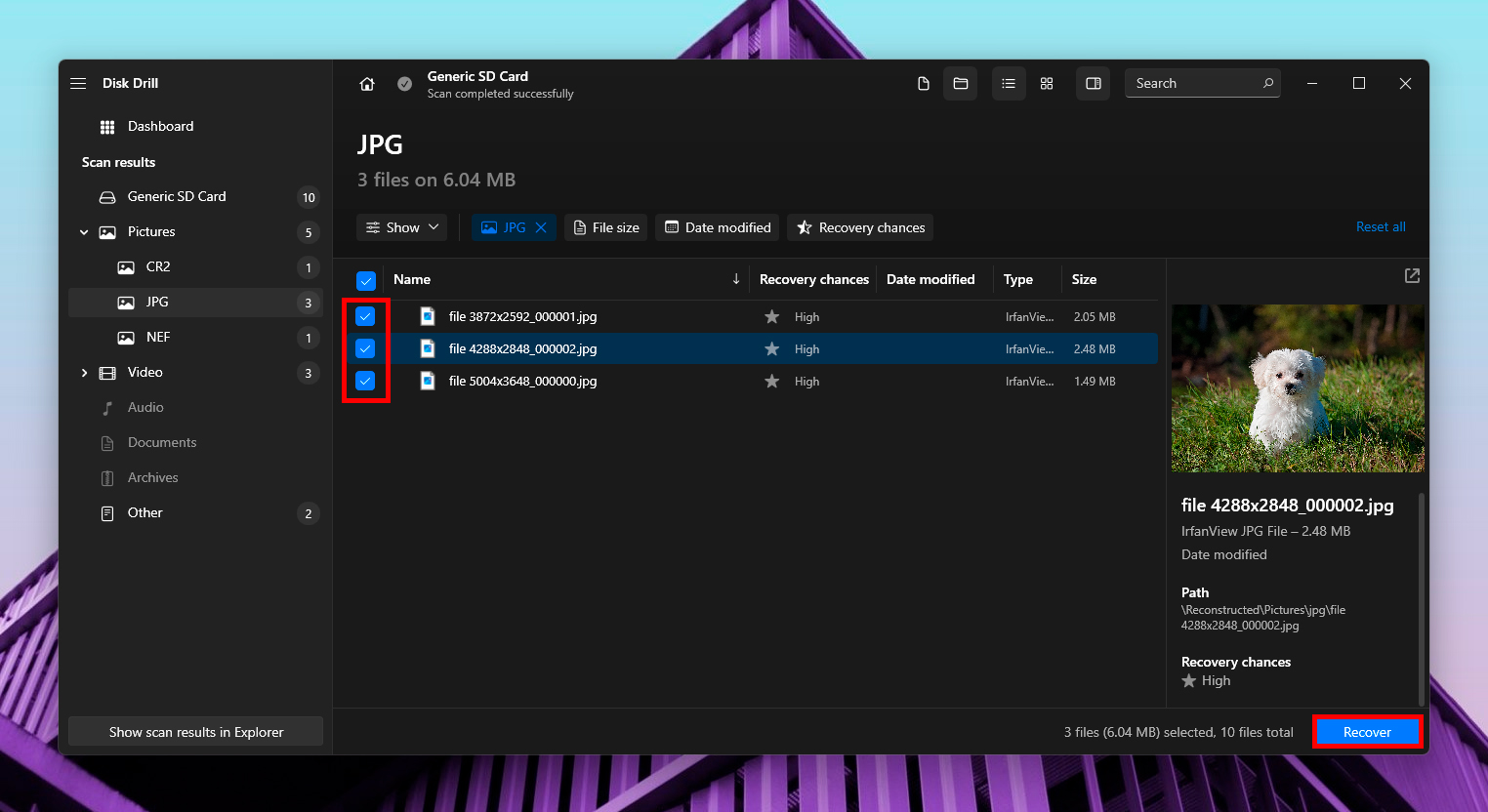
- Complete the recovery process. Select a safe recovery location and save your recovered files. It is important not to save data to the device (memory card) from which you are recovering data to avoid overwriting it during recovery.
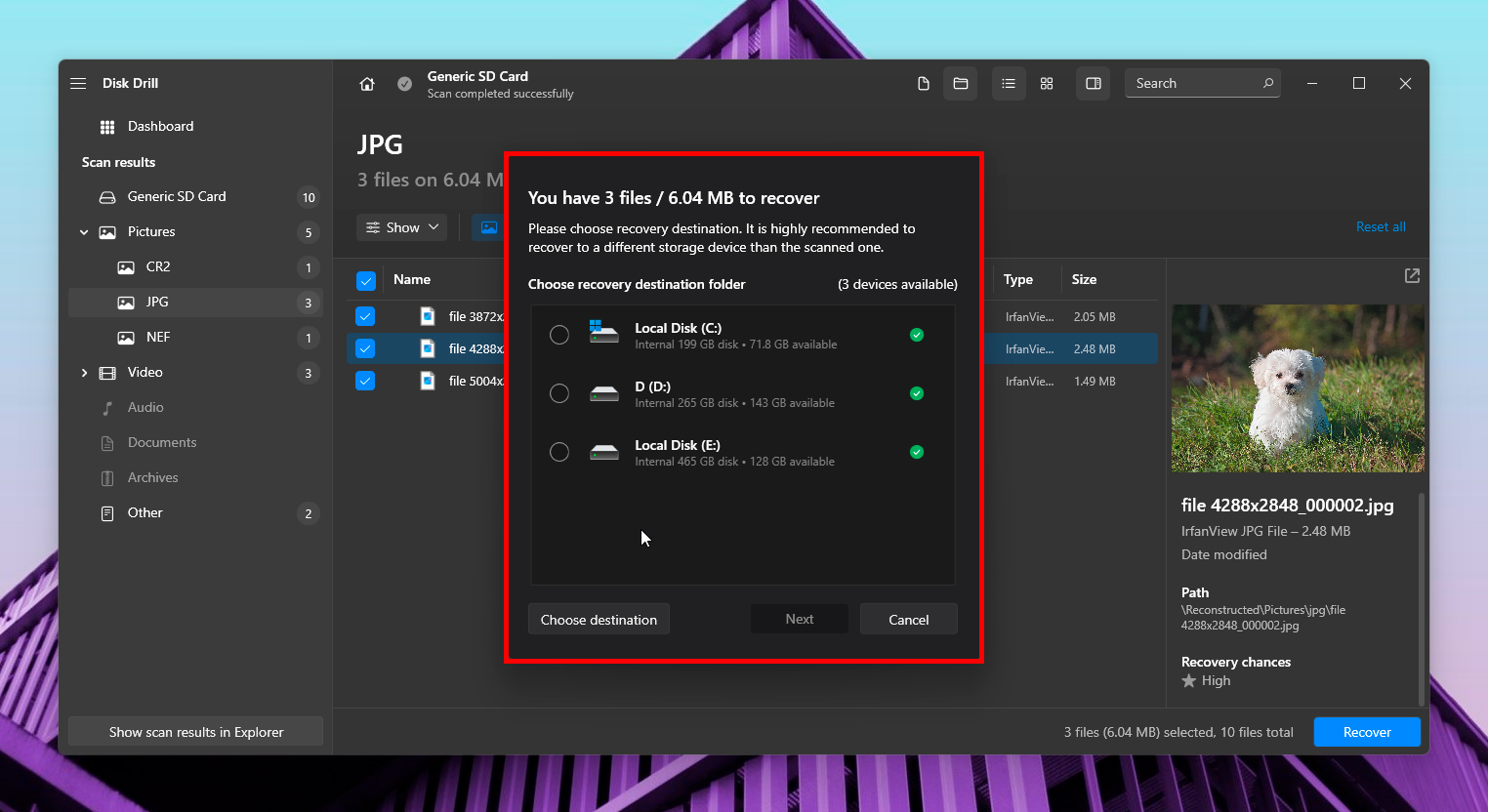
It is important to note that the program globally divides scan results into deleted, reconstructed, and existing files. If the first two directly refer to the files deleted, the last category will be useful to those users who have problems reading their memory card, and who are primarily interested in accessing the existing files on the card, rather than recovering deleted ones.
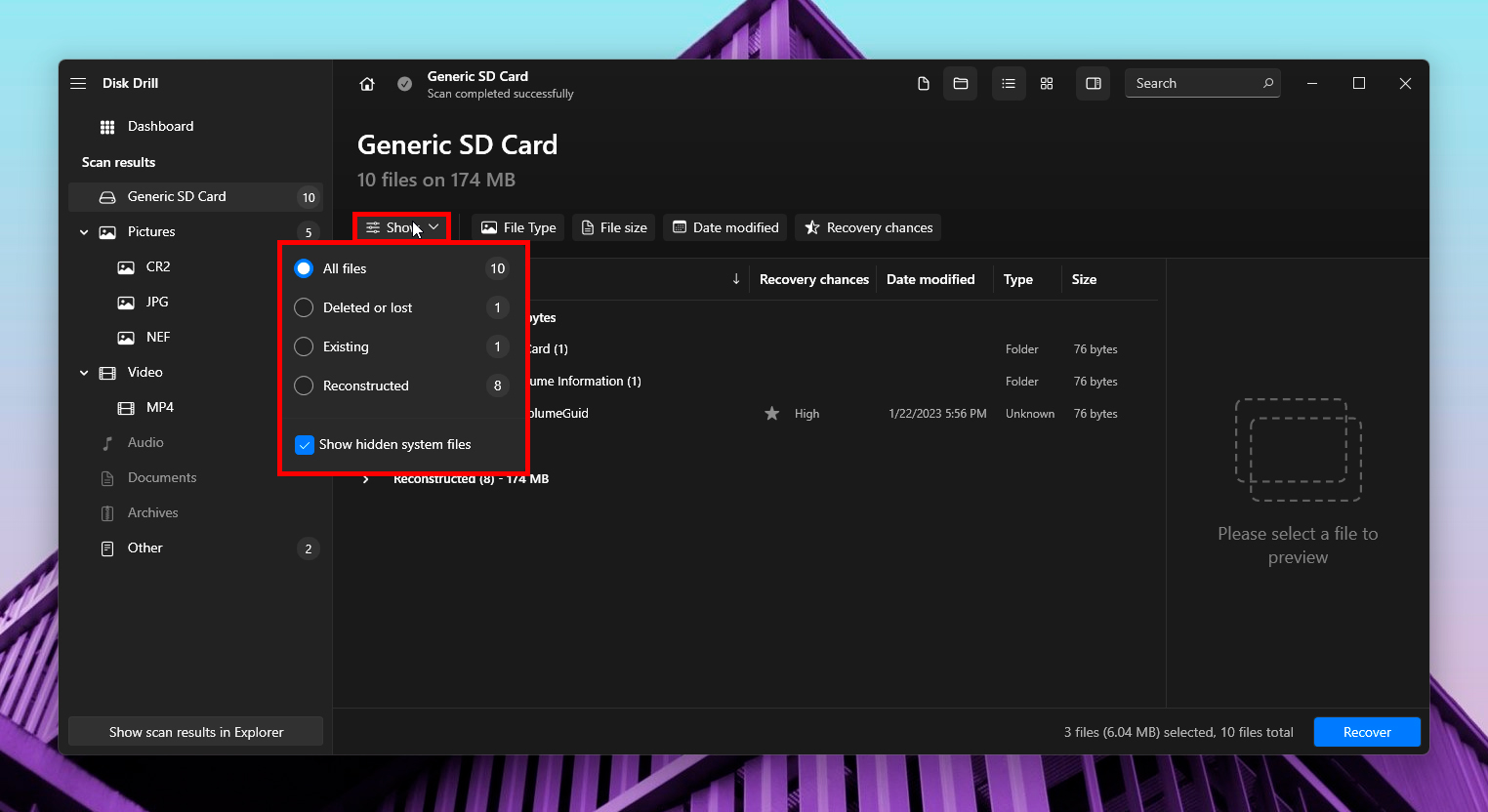
As you can see, Disk Drill succeeded in the task and recovered all our original files. But what to do if for some reason Disk Drill didn’t work for you? We suggest you consider one more software option.
Option B: PhotoRec
PhotoRec is an open-source memory card data recovery software that can be a great alternative to commercial products if you are looking for a capable tool that can be used for free.
Our editorial staff is fond of PhotoRec because, despite its limitations as an open-source product, it handles basic data recovery tasks, including memory card recovery, with a fair degree of confidence.
What might be of interest to you in PhotoRec in the first place:
- PhotoRec is completely free. And even if it doesn’t work for you for some reason, there’s nothing stopping you from giving it a chance and checking if it can help you.
- The program supports a large number of file signatures, including a fair number of RAW photos and videos.
- PhotoRec works with devices (including memory cards) that have a RAW file system or refuse to mount.
- The tool works on Linux.
In various articles and tutorials, PhotoRec is often presented as command-line software, i.e. it works based on the command-line principle (CMD). But surprisingly many people don’t know that Windows machine users can use QPhotoRec – a graphical UI shell for PhotoRec features. It’s still not as easy to use as Disk Drill, but after spending some time you’ll start to get pretty proficient with it.
So, to demonstrate how to recover data from a memory card using PhotoRec, we will use the same memory card as before:
- Download QPhotoRec. We downloaded the tool from this website. It is a portable software tool that does not require installation.
- Run the program. After you unzip the downloaded archive, go to the file folder and run the “qphotorec_win.exe” file.
- Select your memory card in the device list. You can change the selected device using the drop-down menu at the top of the program window.
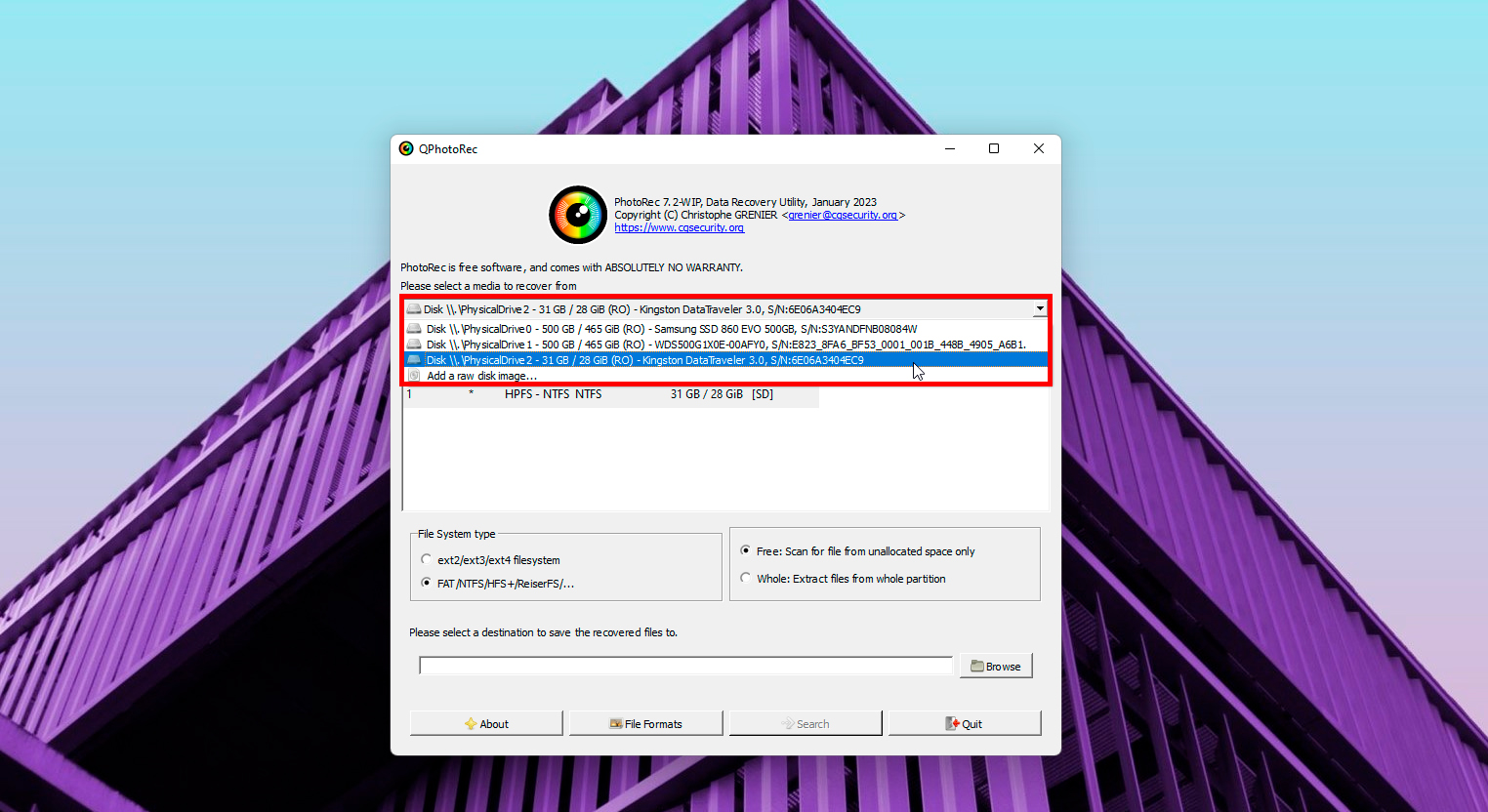
- Configure and run the scan. Before the scan itself, you can select which partition of the device you want to scan, specify the file system of the device, and the method you want to use for scanning. You can either scan data from unallocated space or recover files from the whole partition of the card you have selected. We chose the first option. Also at this step, you can also mark which file types you would like the program to find and recover (by default all available file types are checked). You must also indicate the location where you want the files to be recovered when the scan is complete. Once you have configured the session for your needs, start scanning by clicking the Search button.
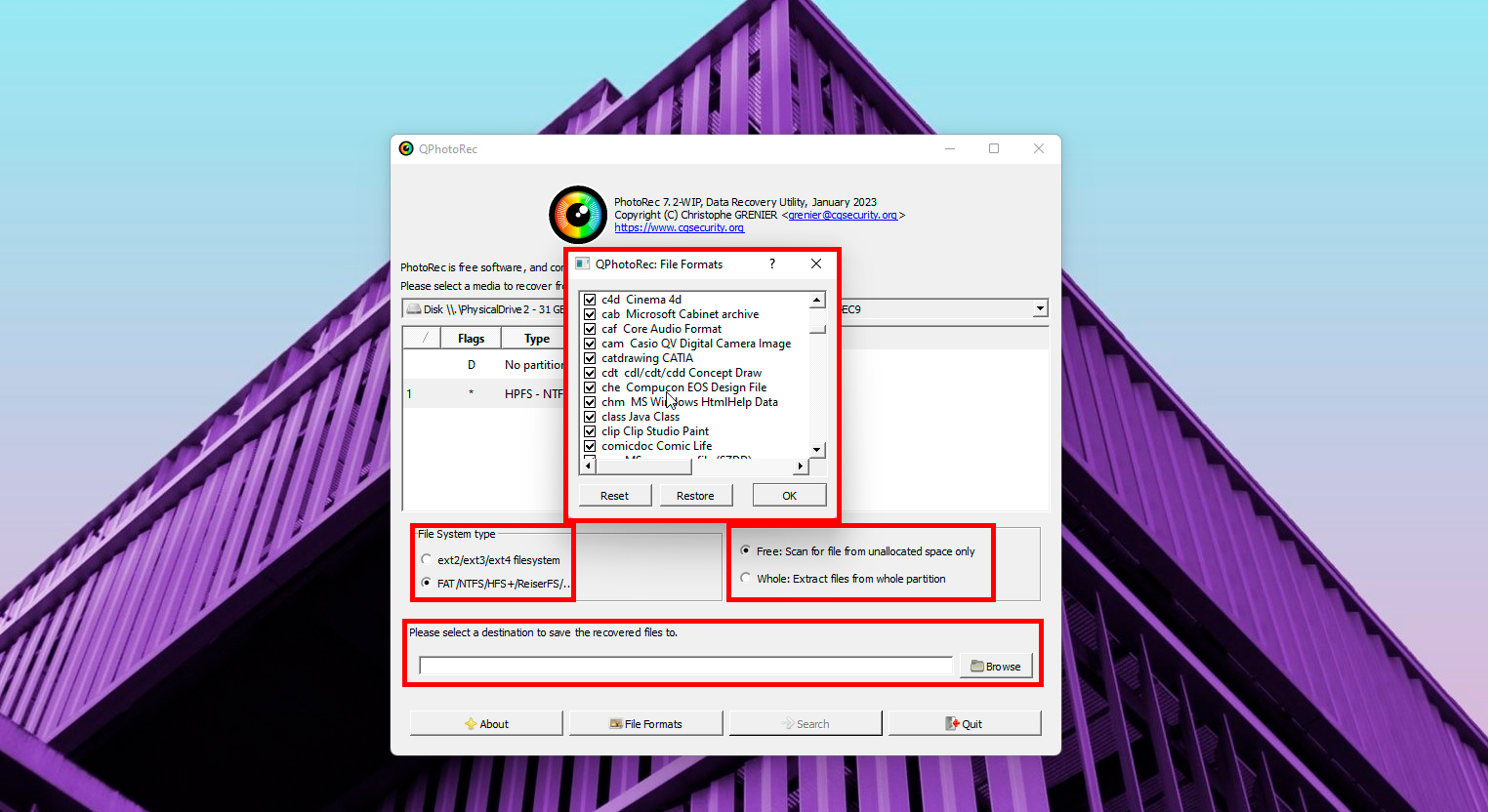
- Wait for the scan to complete. The duration of the scan depends on the same parameters that we described in the previous section. During the scanning process, you will be able to see the progress bar in the form of the number of sectors processed and sectors remaining, as well as what types of files were found during the process and their amount.
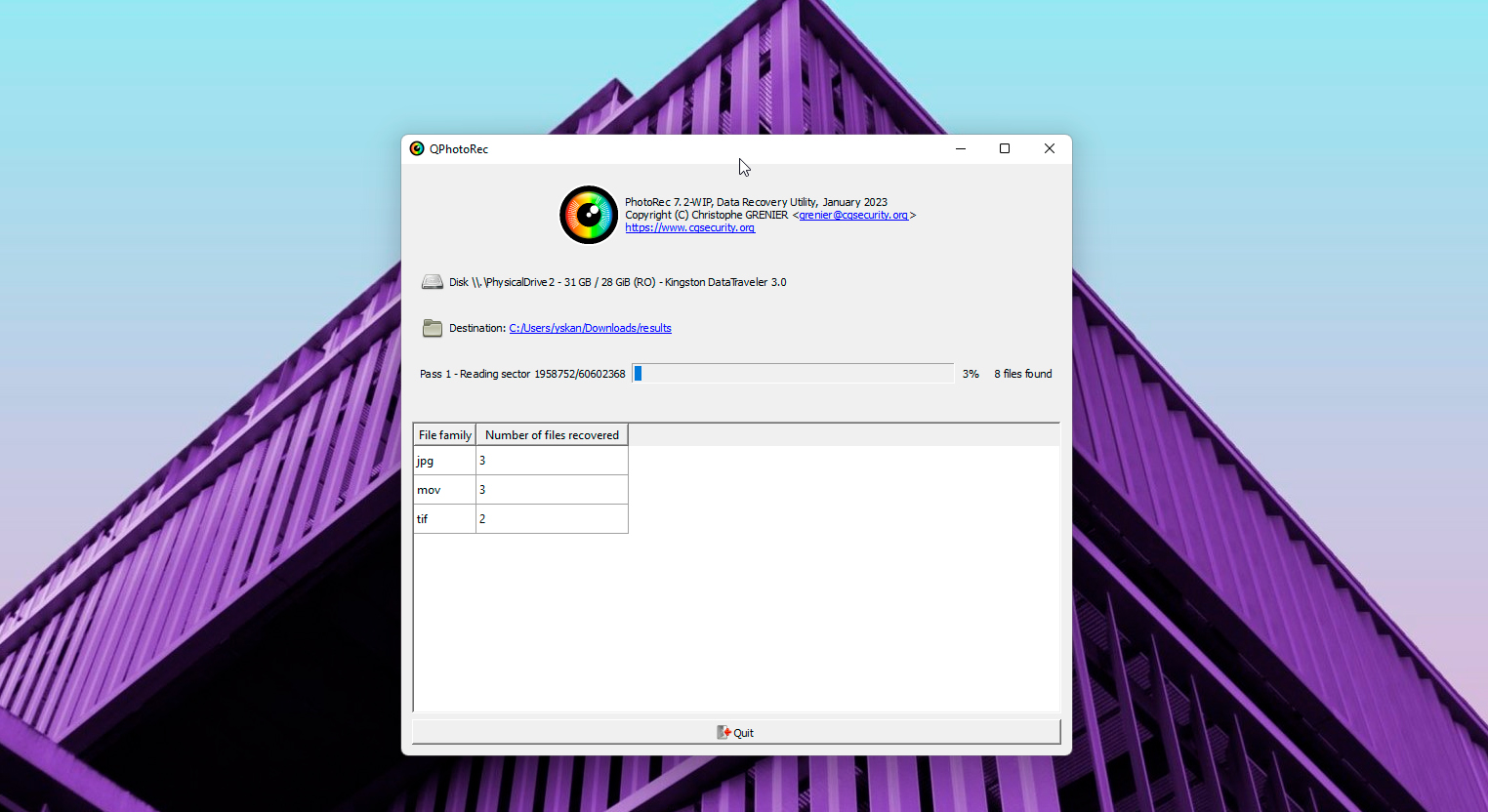
- Finish the scanning process. Once the scanning process is finished you can exit the program by clicking Quit. Next, you will need to go to the folder you specified in the scan settings where you can see the folder with the files PhotoRec was able to recover from your memory card.
As you can see, in our example PhotoRec managed to recover all the data from our card. But unfortunately, unlike Disk Drill, the files were recovered without their original file names.
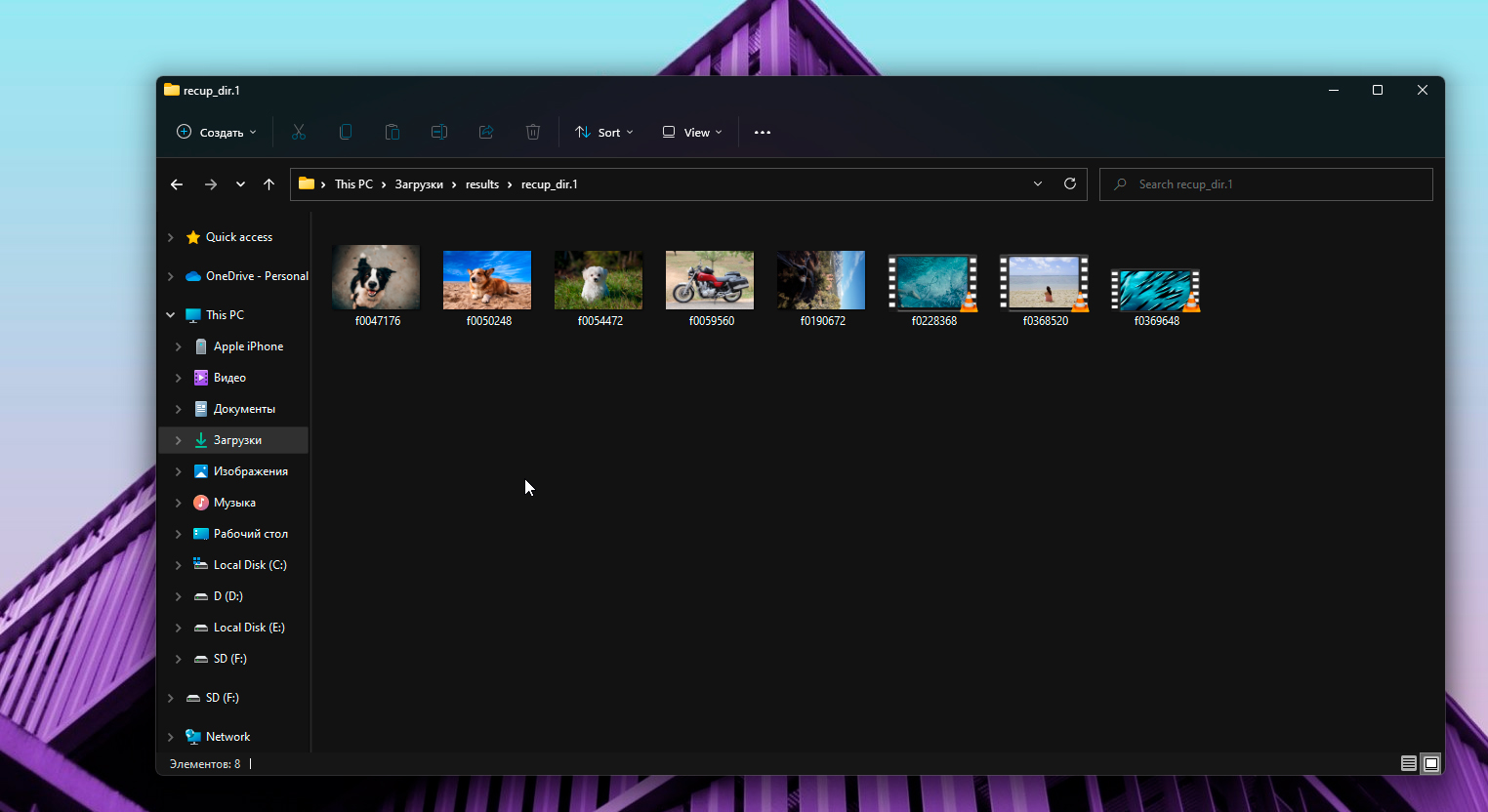
FAQ
How do I recover permanently deleted files from my SD card?
Here is how you can recover permanently deleted files from your memory card:
- Download and install Disk Drill.
- Select the memory card containing the permanently deleted files.
- Click on the Search for lost data button and wait for the scan to finish.
- Preview the files that were found.
- Select a recovery destination to finalize the process.
How to recover deleted files from SD card without software?
You can recover files from a memory card without using software only if the reason for their loss is not permanent deletion but a logical failure of the card itself. In this case, you can use utilities such as chkdsk to check and fix the integrity of the file system on your memory card.
How can I recover deleted files from my SD card for free?
You can recover data from your memory card for free using software with a free trial period like Disk Drill, or completely free software like PhotoRec.
How to recover deleted files from SD card on Android phone?
You can recover deleted data from the memory card you use on your Android phone with special apps that work directly on your phone, for example, DiskDigger photo recovery, but we advise you not to expect much from apple like this. Alternatively, you can remove the card from your phone and connect it to your PC or laptop to scan it with a desktop software tool like Disk Drill or PhotoRec.
Verdict
In this article, we have described in detail how to recover data from your memory card using DIY software without any difficulty. We really hope that you will be able to do the same and rescue your important photos, videos, or any other files.
If for some reason the tools we used in our guide failed for you, you can also pay attention to software like R-Studio, DiskDigger (PC version), or DiskGenius.
If you have any suggestions or comments, please let us know.
